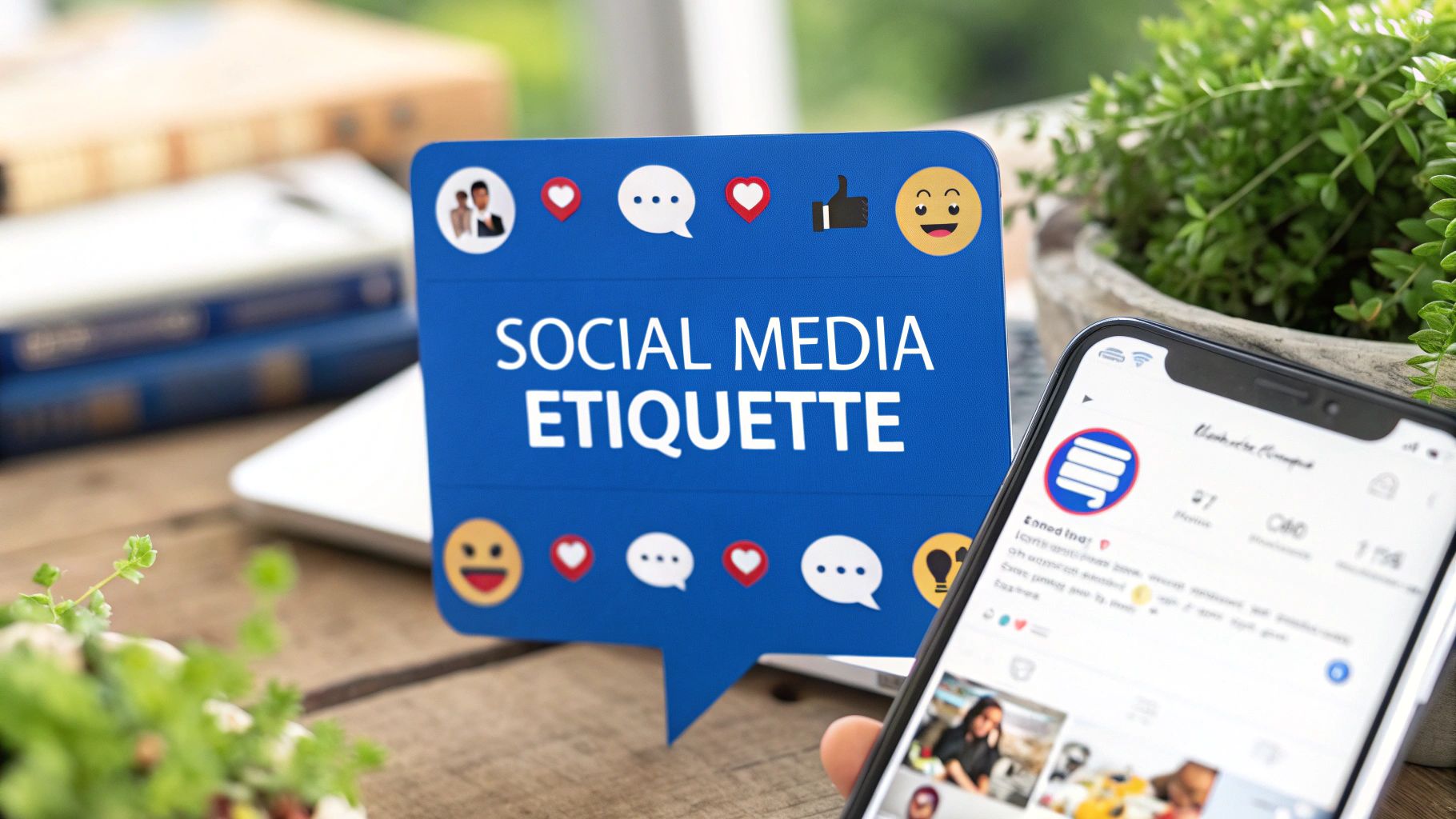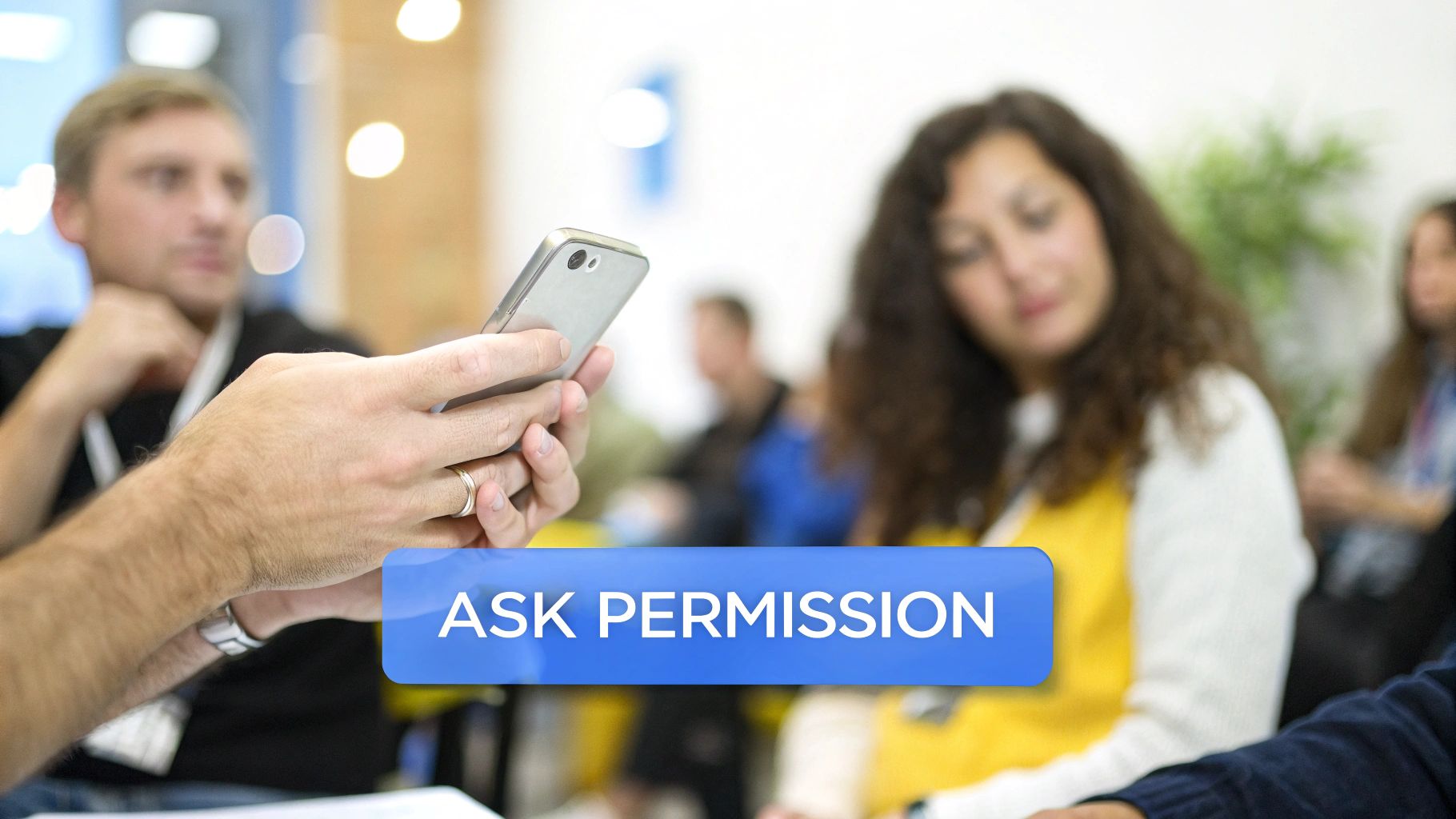8 Social Media Etiquette Tips You Need to Know in 2025
Learn essential social media etiquette rules for 2025 to improve your online presence. Master social media etiquette today for better engagement!

Navigating Instagram for growth feels like learning a new language. You can know all the words-posting, liking, commenting-but if you don't understand the conversational flow and cultural norms, you'll sound awkward and out of place. This is where mastering social media etiquette becomes less about following arbitrary rules and more about strategic communication. True, sustainable growth isn't just about gaming the algorithm; it's about building a genuine community, fostering trust, and establishing your brand as a credible, respected voice in your niche.
This guide moves beyond generic advice. We're not just telling you to "be authentic." Instead, we will provide a clear, actionable framework for implementing proper online conduct directly into your Instagram strategy. You'll learn the unwritten rules that separate amateur accounts from professional, high-growth profiles. From handling negative feedback with grace to giving credit in a way that builds bridges, each point is designed to be a practical tool. Following this etiquette isn't just about being polite; it's a direct investment in your brand's reputation and long-term success. Think of this as your playbook for building a powerful, respected, and rapidly growing presence.
1. The First Commandment: Think Before You Post
In the fast-paced world of social media, the temptation to post impulsively is strong. However, the most fundamental rule of social media etiquette is to pause and think before sharing. This principle involves a conscious, deliberate review of your content to ensure it aligns with your brand values, resonates with your target audience, and avoids potential negative repercussions. It’s about moving from reactive posting to strategic communication.

This proactive approach is championed by top-tier professionals for a reason. Companies like BoostFluence implement internal review processes to maintain brand consistency and quality. Similarly, high-profile influencers and politicians often rely on social media managers to vet content, preventing costly mistakes that could alienate followers or damage their reputation. The goal isn't to stifle authenticity but to ensure your message is intentional and constructive.
How to Implement This Practice
Applying this rule doesn't require a full team; it's a mindset shift that can be supported by simple habits. The core idea is to create a small gap between content creation and publication for reflection.
- Use the 24-Hour Rule: For any content that feels emotionally charged or potentially controversial, wait 24 hours before posting. This cooling-off period allows you to revisit the post with a clearer, more objective perspective.
- Read It Aloud: Tone is notoriously difficult to convey through text. Reading your caption or comment aloud can help you catch awkward phrasing or a tone that might be misinterpreted as sarcastic or aggressive. If you are not sure what caption to use, try BoostFluence Free Captions Generator that will give you a professional or casual caption.
- Audience Perspective Check: Ask yourself how different segments of your audience might interpret your post. A joke that lands well with one group might be offensive to another. Proper social media etiquette involves considering your entire community.
- The In-Person Test: A powerful filter is to ask, "Would I say this to someone's face in a professional setting?" If the answer is no, it probably doesn't belong on your brand’s Instagram profile.
{{INTERN}}
2. Respect Others' Privacy
In an era of constant sharing, a crucial element of social media etiquette is respecting the privacy of others. This principle extends beyond your own account to how you feature other people in your content. It involves obtaining consent before sharing photos, videos, or personal stories that involve others and being mindful of their digital footprint. Just because you are comfortable sharing a moment doesn't mean everyone in that moment is.

This practice is strongly advocated by digital citizenship educators and privacy organizations like the Electronic Frontier Foundation. Major platforms have even built features around this concept, such as Instagram’s "Close Friends" list for selective story sharing or Facebook’s tag approval settings, which give users control over their public image. These tools underscore a fundamental truth: respecting personal boundaries is as important online as it is offline, especially for brands and creators building trust with their community.
How to Implement This Practice
Integrating this rule into your social media strategy demonstrates respect and professionalism. It’s about being considerate of the people who are part of your brand's journey, both online and off.
- Always Ask Before Tagging: Before you tag someone in a photo, especially if it's unflattering or reveals their location, send a quick message to ask for permission. This simple courtesy can prevent awkwardness and shows you value their consent.
- Respect Removal Requests: If someone asks you to remove a tag or take down a photo they are in, do so promptly and without argument. Their comfort and privacy should be your priority.
- Don't Share Second-Hand Stories: Avoid sharing personal information or anecdotes about friends, clients, or colleagues without their explicit permission. Their stories are theirs to tell, not yours.
- Be Mindful of Your Background: When taking photos or videos in public or at events, be conscious of who is in the background. Avoid capturing individuals who might not want to appear in your content, or use blurring effects if necessary.
3. Engage Authentically and Meaningfully
The third rule of social media etiquette is to engage meaningfully, moving beyond superficial responses to create genuine connections. This practice involves investing time in thoughtful commenting, sincere reactions, and building real relationships rather than simply chasing vanity metrics or using generic, automated replies. It’s the difference between being present in a conversation and just being a name on an engagement list.

This philosophy is championed by community management experts and authentic brand advocates who understand that loyalty is built through trust, not just transactions. Brands like Wendy's have famously used witty, personalized responses on Twitter to build a distinctive and beloved online personality. Similarly, influencers like Brené Brown engage deeply with their community by responding to comments with empathy and insight, fostering a highly dedicated following. This approach transforms your social media presence from a simple broadcast channel into a thriving community hub.
How to Implement This Practice
Adopting authentic engagement is about prioritizing quality over quantity in your interactions. It requires a shift from a numbers-first mindset to a people-first one, which can be cultivated through specific, deliberate habits.
- Read Before You Reply: Always take a moment to read the entire post and caption before commenting. Responding to just a headline or image can lead to irrelevant or embarrassing misinterpretations, undermining your credibility.
- Ask Thoughtful Questions: Instead of a generic "Nice post!", ask an open-ended question related to the content. This invites a deeper conversation, shows you've paid attention, and encourages a meaningful response.
- Share Relevant Experiences: When appropriate, share a brief, relevant personal anecdote or experience. This adds value to the conversation and helps humanize your brand, making your interactions more memorable and relatable.
- Avoid Generic Comments: Steer clear of one-word comments like "Great!" or "Awesome!" as they are often perceived as spammy or automated. A specific, detailed compliment or observation is far more impactful in modern social media etiquette. If you want to dive deeper into building these connections, you can explore various community engagement strategies. Learn more about effective community engagement on boostfluence.com.
Automate the Right Way with Boostfluence
While authentic engagement requires a personal touch, that doesn’t mean you have to handle everything manually. Tools like Boostfluence help you scale your Instagram presence without sacrificing authenticity. By intelligently automating likes, comments, and DMs based on custom targeting, Boostfluence enables you to focus your energy on deeper interactions—the ones that actually build community.
For example, you can set your automation to engage only with content that matches your niche, and personalize comment templates to feel human and relevant. This lets you maintain a people-first strategy while still growing efficiently.
If you're serious about building real relationships at scale, Boostfluence offers the support system to do it with intention and integrity.
4. Use Appropriate Language and Tone
Your choice of words and the tone you convey are the digital equivalent of your brand’s voice and body language. Mastering this aspect of social media etiquette involves tailoring your communication to be professional, respectful, and contextually appropriate for each platform. It’s about recognizing that the witty, fast-paced tone that thrives on Twitter might not resonate on the professional network of LinkedIn, and your language must adapt accordingly.

This principle is a cornerstone of corporate communication strategies and is championed by professional communication experts. Brands like Wendy's have famously mastered a sassy, humorous tone on Twitter, but this is a deliberate and consistent brand choice. For most, a baseline of respectful, clear, and inclusive language is the safest and most effective approach. The goal is to build trust and community, which requires speaking in a way that makes your audience feel seen and valued.
How to Implement This Practice
Adapting your tone isn't about creating multiple brand personalities; it's about adjusting your delivery for different conversational settings. Consistent and thoughtful language choices will strengthen your brand identity and foster a positive community environment.
- Match the Platform's Culture: Adjust your tone to fit the unspoken rules of each platform. LinkedIn calls for a professional and industry-focused voice, while Instagram favors a more personal, visually-driven narrative. Your language should complement the platform's primary function.
- Avoid Ambiguous Jargon and Slang: While using trendy terms can seem relatable, it can also alienate or confuse segments of your audience who aren't familiar with them. Prioritize clear, accessible language that everyone can understand.
- Embrace Inclusive Language: Use words and phrases that are welcoming to people of all backgrounds, genders, and abilities. Simple changes, like using "everyone" or "folks" instead of "guys," make a significant difference in creating an inclusive space.
- Proofread Meticulously: Typos and grammatical errors can undermine your credibility and make your brand appear careless. Always double-check your captions, comments, and direct messages before hitting send. To improve your writing for platforms like Instagram, you can explore specialized techniques; discover more about crafting the perfect captions to enhance your special writing for Instagram.
5. Give Credit Where Credit Is Due
In the digital ecosystem, content is currency, and proper attribution is the foundation of ethical exchange. Giving credit where it is due involves the practice of clearly and accurately acknowledging the original creator of any content you share, whether it's an image, a quote, an idea, or a video. This principle goes beyond simple politeness; it is a critical component of professional social media etiquette that upholds intellectual property rights and fosters a collaborative, respectful community.
This standard is championed by creative communities and enforced by platform policies. For instance, Instagram's culture has evolved to frown upon accounts that repost without clear attribution, while Pinterest's core functionality is built on linking back to original sources. For brands and creators, failing to give credit not only risks public backlash but can also lead to copyright infringement issues. Proper attribution builds trust with your audience and shows respect for the creative labor of others, strengthening your digital reputation.
How to Implement This Practice
Integrating proper attribution into your workflow is a non-negotiable skill for anyone serious about building a positive brand presence. It’s about creating a system to track and honor the sources of the content that inspires and populates your feed.
- Tag and Mention Directly: The most effective method is to tag the creator’s handle directly in the photo or video and mention them in the very first lines of your caption. Avoid burying credit at the end of a long caption or in the comments.
- Ask for Permission: The gold standard of social media etiquette is to ask for permission before you share someone else's content. A simple direct message not only ensures you have consent but also opens the door for networking and collaboration.
- Use Reverse Image Search: If you find an image without a clear source, use tools like Google Images or TinEye to trace it back to the original creator. Never use content where the creator cannot be identified or credited.
- Avoid "Credit to the Owner": Phrases like "credit to creator" or "image found on Pinterest" are insufficient. They place the burden of finding the source on your audience and signal a lack of due diligence. Always provide a direct name or link.
6. Don't Overshare Personal Information
The line between authenticity and oversharing is a critical boundary in modern social media etiquette. While sharing personal stories can build a powerful connection with your audience, divulging too much sensitive information can compromise your privacy, security, and professional image. This rule is about maintaining appropriate boundaries and being mindful of the long-term implications of what you post online.
This principle is heavily promoted by digital privacy advocates and cybersecurity experts who regularly see the negative consequences of oversharing. From identity theft to reputational damage, the risks are real. Brands and creators who master this balance are able to foster trust and community without exposing themselves or their followers to unnecessary danger. It's about being relatable, not reckless.
How to Implement This Practice
Adopting a privacy-conscious mindset is key to navigating the complexities of online sharing. It involves creating a personal or brand-level policy on what information remains private, ensuring every post is a deliberate choice.
- Delay Your Location Sharing: Avoid posting your real-time location. If you want to share a picture from a café or event, wait until you have left the venue. This simple habit prevents unwanted attention and enhances personal security.
- Keep Sensitive Details Private: Never post images of your credit cards, driver's license, or personal documents. Be cautious about sharing your home address, specific financial details, or your full birthdate, as this information can be exploited by malicious actors.
- Draw a Line on Personal Drama: While vulnerability is valued, your Instagram feed is not the place for detailed accounts of family conflicts or personal disputes. This type of content can alienate your audience and damage your professional reputation.
- Review Your Content's Digital Footprint: The information you share today could be used in ways you don't intend tomorrow. For those particularly conscious about how their shared content is used, understanding how to manage AI training on your content on platforms like Meta is increasingly important.
7. Be Mindful of Timing and Frequency
Effective social media etiquette extends beyond what you post; it also involves when and how often you post. Strategic timing and frequency are crucial for maximizing reach and engagement without overwhelming or annoying your audience. This principle involves understanding your audience's online habits and platform algorithms to deliver content when it’s most likely to be seen and appreciated. It's the difference between shouting into a void and speaking to an engaged room.
This strategic approach is a cornerstone of professional content strategy. Businesses use scheduling tools like Hootsuite or Later to analyze data and automate posts for peak times, ensuring their content gets maximum visibility. Likewise, successful influencers don't post randomly; they monitor their analytics to identify when their followers are most active. This data-driven practice shows respect for your followers' time and attention, preventing your valuable content from getting lost in a cluttered feed.
How to Implement This Practice
Mastering timing and frequency doesn't require a crystal ball. It’s about leveraging available data and establishing a rhythm that works for your specific audience. The goal is to create a consistent, reliable presence.
- Analyze Your Insights: Use your platform’s built-in analytics (like Instagram Insights) to identify the days and hours your followers are most active. This is the most reliable source of data for your unique audience. To dive deeper, you can learn more about the best times to post on Instagram on boostfluence.com.
- Establish a Consistent Schedule: Whether you post daily or three times a week, create a consistent schedule. This trains the algorithm to anticipate your content and helps your audience know when to expect new posts from you.
- Space Out Your Posts: Avoid "content dumping" or posting multiple times in a short period. This can appear spammy and may cause followers to mute or unfollow you. Give each post room to breathe and garner engagement.
- Pause During Sensitive Events: A key aspect of social media etiquette is situational awareness. Refrain from posting promotional content during major tragedies or sensitive global events. Pausing your schedule shows respect and empathy.
{{INTERN}}
8. Handle Conflicts and Criticism Gracefully
Negative feedback and public criticism are inevitable realities in the digital landscape. Proper social media etiquette dictates that you handle these situations not as personal attacks, but as opportunities to demonstrate professionalism and strengthen community trust. This principle involves responding constructively, avoiding public arguments, and knowing when to move a conversation to a private channel. It’s about managing your online reputation by turning potential crises into displays of accountability and grace.
This strategic approach is a cornerstone of modern crisis communication and customer service. Brands like Starbucks often respond to public criticism by acknowledging the feedback and detailing corrective actions, reinforcing their commitment to customer satisfaction. Similarly, effective customer service accounts on Instagram quickly guide frustrated users to DMs, de-escalating the situation publicly while resolving it privately. The goal is not to win an argument but to protect your brand’s integrity and show your audience you value their input, even when it's negative.
How to Implement This Practice
Mastering this skill requires a blend of empathy, strategy, and self-control. The key is to have a clear, repeatable process for managing negative interactions before they spiral out of control.
- Acknowledge and Redirect: The first step is to publicly acknowledge the user's comment. A simple, "We're sorry you had this experience. Please send us a DM with more details so we can help," shows you're responsive while moving the specific complaint out of the public eye.
- Respond, Don't React: Never reply in the heat of the moment. Take time to cool down and analyze the criticism objectively. Is there a valid point? Formulate a calm, professional response that addresses the issue without becoming defensive.
- Know When to Disengage: Not every comment warrants a response. Trolls or users engaging in bad-faith arguments should be ignored, muted, or blocked. Engaging with them only amplifies their negativity and drains your resources.
- The "Thank You for the Feedback" Filter: Frame criticism as feedback. Responding with, "Thank you for bringing this to our attention," can immediately diffuse tension. It validates the person's feelings and positions your brand as one that is open to improvement, a crucial aspect of good social media etiquette.
8-Point Social Media Etiquette Comparison
Turning Etiquette into Engagement: Your Blueprint for Growth
Navigating the digital landscape of Instagram requires more than just compelling visuals and clever captions; it demands a sophisticated understanding of social media etiquette. As we've explored, the unwritten rules of online interaction are not merely suggestions but the very foundation upon which sustainable growth is built. Mastering these principles transforms your presence from that of a passive broadcaster to an active, respected member of the community.
The journey from awareness to mastery begins with a simple, yet profound, shift in perspective. Instead of viewing these guidelines as restrictive, see them as strategic tools. Each point, from thinking before you post to handling criticism with grace, is an opportunity to strengthen your brand identity, build trust, and foster genuine connections that drive meaningful engagement.
From Principles to Practice: Your Actionable Roadmap
To truly integrate this knowledge, it's crucial to move from reading to doing. The most successful entrepreneurs, creators, and brands are those who consistently apply these etiquette standards until they become second nature. They understand that a single thoughtless comment or a failure to give proper credit can unravel months of hard work.
Here is a summary of the core takeaways and your immediate next steps:
- Intentionality is Key: Every post, comment, and direct message should be deliberate. Revisit the "Think Before You Post" principle and make it a pre-flight check for all your content. Ask yourself: Does this align with my brand? Does it add value to my community?
- Authenticity Drives Connection: Move beyond generic responses. Implement the "Engage Authentically" rule by setting aside time each day to leave thoughtful, personalized comments on posts from your followers and peers. This is where real relationships are forged.
- Respect is Non-Negotiable: Upholding privacy, giving credit, and using appropriate language are the pillars of digital respect. This aspect of social media etiquette is paramount for building a positive reputation and a safe community space around your brand.
- Grace Under Pressure Defines You: How you manage conflict and criticism is a direct reflection of your brand's maturity and professionalism. When faced with negativity, refer back to our strategies for handling it gracefully, turning potential crises into opportunities to demonstrate leadership.
Ultimately, impeccable social media etiquette is the silent engine of organic growth. It’s what separates fleeting trends from lasting influence and fleeting followers from a loyal community. By internalizing these practices, you are not just avoiding common pitfalls; you are actively crafting a brand presence that is magnetic, trustworthy, and built for long-term success. The digital world remembers, and a reputation built on respect and authenticity is your most valuable asset.
Ready to put these principles into action but need help scaling your authentic engagement and influencer collaborations? BoostFluence provides the tools to manage your campaigns efficiently, ensuring every interaction aligns with perfect social media etiquette. Discover how our platform can streamline your growth at BoostFluence.
Want to Grow Your Instagram?
Use BoostFluence tools to grow your followers, engagement, and authority — for ambitious agencies, businesses and creators.



Get More Instagram Followers
Reach your target audience and grow your followers with interactive campaigns.

Swipe Up to Get More Followers!

Get More Instagram Followers
Reach your target audience and grow your followers with interactive campaigns.




